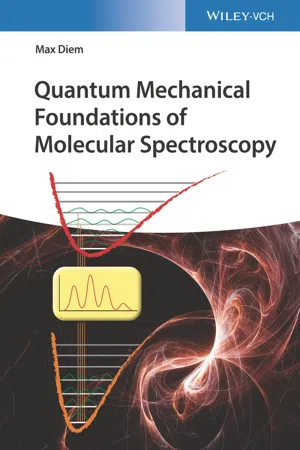
- English
- ePUB (mobile friendly)
- Available on iOS & Android
Quantum Mechanical Foundations of Molecular Spectroscopy
About this book
A concise textbook bridging quantum theory and spectroscopy!
Designed as a practical text, Quantum Mechanical Foundations of Molecular Spectroscopy covers the quantum mechanical fundamentals of molecular spectroscopy from the view of a professional spectroscopist, rather than a theoretician. Written by a noted expert on the topic, the book puts the emphasis on the relationship between spectroscopy and quantum mechanics, and provides the background information and derivations of the subjects needed to understand spectroscopy including: stationary energy states, transitions between these states, selection rules, and symmetry.
The phenomenal growth of all forms of spectroscopy over the past eight decades has contributed enormously to our understanding of molecular structure and properties. Today spectroscopy covers a broad field including the modern magnetic resonance techniques, non-linear, laser and fiber-based spectroscopy, surface and surface-enhanced spectroscopy, pico- and femtosecond time resolved spectroscopy, and many more. This up-to-date resource discusses several forms of spectroscopy that are used in many fields of science, such as fluorescence, surface spectroscopies, linear and non-linear Raman spectroscopy and spin spectroscopy. This important text:
- Contains the physics and mathematics needed to understand spectroscopy
- Explores spectroscopic methods the are widely used in chemistry, biophysics, biology, and materials science
- Offers a text written by an experienced lecturer and practitioner of spectroscopic methods
- Includes detailed explanations and worked examples
Written for chemistry, biochemistry, material sciences, and physics students, Quantum Mechanical Foundations of Molecular Spectroscopy provides an accessible text for understanding molecular spectroscopy.
Frequently asked questions
- Essential is ideal for learners and professionals who enjoy exploring a wide range of subjects. Access the Essential Library with 800,000+ trusted titles and best-sellers across business, personal growth, and the humanities. Includes unlimited reading time and Standard Read Aloud voice.
- Complete: Perfect for advanced learners and researchers needing full, unrestricted access. Unlock 1.4M+ books across hundreds of subjects, including academic and specialized titles. The Complete Plan also includes advanced features like Premium Read Aloud and Research Assistant.
Please note we cannot support devices running on iOS 13 and Android 7 or earlier. Learn more about using the app.
Information
1
Transition from Classical Physics to Quantum Mechanics
Table of contents
- Cover
- Table of Contents
- Title Page
- Copyright
- Preface
- Introduction
- 1 Transition from Classical Physics to Quantum Mechanics
- 2 Principles of Quantum Mechanics
- 3 Perturbation of Stationary States by Electromagnetic Radiation
- 4 The Harmonic Oscillator, a Model System for the Vibrations of Diatomic Molecules
- 5 Vibrational Infrared and Raman Spectroscopy of Polyatomic Molecules
- 6 Rotation of Molecules and Rotational Spectroscopy
- 7 Atomic Structure: The Hydrogen Atom
- 8 Nuclear Magnetic Resonance (NMR) Spectroscopy
- 9 Atomic Structure: Multi‐electron Systems
- 10 Electronic States and Spectroscopy of Polyatomic Molecules
- 11 Group Theory and Symmetry
- Appendix 1: Constants and Conversion Factors
- Appendix 2: Approximative Methods: Variation and Perturbation Theory
- Appendix 3: Nonlinear Spectroscopic Techniques
- Appendix 4: Fourier Transform (FT) Methodology
- Appendix 5: Description of Spin Wavefunctions by Pauli Spin Matrices
- Index
- End User License Agreement